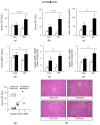Maternal Consumption of Low-Isoflavone Soy Protein Isolate Confers the Increased Predisposition to Alcoholic Liver Injury in Adult Rat Offspring
- PMID: 29534433
- PMCID: PMC5872750
- DOI: 10.3390/nu10030332
Maternal Consumption of Low-Isoflavone Soy Protein Isolate Confers the Increased Predisposition to Alcoholic Liver Injury in Adult Rat Offspring
Abstract
Offspring of female rats fed either a casein (CAS) diet or a low-isoflavone soy protein isolate (SPI) diet were compared in an animal model of chronic ethanol consumption to investigate whether maternal diet regulates the adaptive responses of offspring to postnatal ethanol exposure and potentially affects the development of liver disease in later life. Female rats were fed either a CAS or an SPI diet before mating, and during pregnancy and lactation. Male offspring from the same litter were pair-fed either a control or ethanol diet for six weeks (CAS/CON, CAS/EtOH, SPI/CON, and SPI/EtOH groups). Serum aminotransferase activities and hepatic inflammatory indicators were higher in the SPI/EtOH group than in the CAS/EtOH group. Ethanol consumption increased serum homocysteine levels, hepatic S-adenosylmethionine:S-adenosylhomocysteine ratio, and hepatic endoplasmic reticulum stress only in offspring of SPI-fed female rats. Total and high-density lipoprotein (HDL) cholesterol levels and mRNA levels of hepatic genes involved in HDL cholesterol assembly were reduced in the SPI group in response to ethanol consumption. In conclusion, offspring of SPI-fed female rats were more susceptible to the later development of alcoholic liver disease than offspring of CAS-fed female rats. Furthermore, maternal SPI consumption altered one-carbon metabolism and cholesterol metabolism of offspring fed an ethanol diet.
Keywords: HDL cholesterol; alcoholic liver disease; one-carbon metabolism; rat offspring; soy protein isolate.
Conflict of interest statement
The authors declare no conflict of interest. The funding sponsors had no role in the design of the study; in the collection, analyses, or interpretation of data; in the writing of the manuscript, and in the decision to publish the results.
Figures









Similar articles
-
Maternal Consumption of a Low-Isoflavone Soy Protein Isolate Diet Accelerates Chemically Induced Hepatic Carcinogenesis in Male Rat Offspring.Nutrients. 2020 Feb 22;12(2):571. doi: 10.3390/nu12020571. Nutrients. 2020. PMID: 32098370 Free PMC article.
-
Maternal consumption of low-isoflavone soy protein isolate alters hepatic gene expression and liver development in rat offspring.J Nutr Biochem. 2017 Apr;42:51-61. doi: 10.1016/j.jnutbio.2016.12.013. Epub 2017 Jan 12. J Nutr Biochem. 2017. PMID: 28126648
-
Different Effects of Maternal Low-Isoflavone Soy Protein and Genistein Consumption on Hepatic Lipid Metabolism of 21-Day-Old Male Rat Offspring.Nutrients. 2017 Sep 20;9(9):1039. doi: 10.3390/nu9091039. Nutrients. 2017. PMID: 28930193 Free PMC article.
-
Effects of ethanol on lipid metabolism.J Lipid Res. 1979 Mar;20(3):289-315. J Lipid Res. 1979. PMID: 87483 Review.
-
Excessive early-life cholesterol exposure may have later-life consequences for nonalcoholic fatty liver disease.J Dev Orig Health Dis. 2021 Apr;12(2):229-236. doi: 10.1017/S2040174420000239. Epub 2020 Apr 15. J Dev Orig Health Dis. 2021. PMID: 32290895 Free PMC article. Review.
Cited by
-
Soy isoflavone reduces LPS-induced acute lung injury via increasing aquaporin 1 and aquaporin 5 in rats.Open Life Sci. 2023 Feb 10;18(1):20220560. doi: 10.1515/biol-2022-0560. eCollection 2023. Open Life Sci. 2023. PMID: 36820212 Free PMC article.
-
Maternal Consumption of a Low-Isoflavone Soy Protein Isolate Diet Accelerates Chemically Induced Hepatic Carcinogenesis in Male Rat Offspring.Nutrients. 2020 Feb 22;12(2):571. doi: 10.3390/nu12020571. Nutrients. 2020. PMID: 32098370 Free PMC article.
References
-
- Martin-Gronert M.S., Tarry-Adkins J.L., Cripps R.L., Chen J.-H., Ozanne S.E. Maternal protein restriction leads to early life alterations in the expression of key molecules involved in the aging process in rat offspring. Am. J. Physiol. Regul. Integr. Comp. Physiol. 2008;294:R494–R500. doi: 10.1152/ajpregu.00530.2007. - DOI - PubMed
MeSH terms
Substances
LinkOut - more resources
Full Text Sources
Other Literature Sources
Medical

